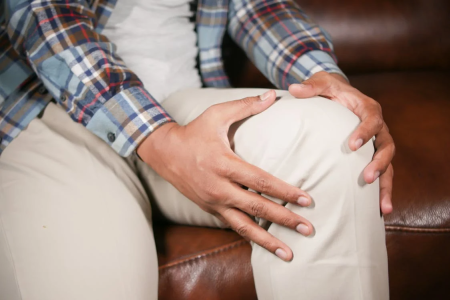At last—a breakthrough that could change life with rheumatoid arthritis!
By
Maan
- Replies 0
It’s a condition that can make even the simplest tasks feel impossible—yet new research may have uncovered a surprising solution.
A novel approach to exercise is turning heads for its ability to ease pain and build strength in those living with chronic joint issues.
Now, scientists believe it could be a breakthrough for thousands of older Australians.
For people living with rheumatoid arthritis (RA), the physical toll can be relentless—pain, fatigue and declining strength often make traditional workouts feel more like punishment than progress.
But in a small new study funded by Arthritis Australia, researchers from the University of South Australia trialled an unconventional training method that could offer a more manageable alternative: blood flow restricted resistance training.
Instead of lifting heavy weights, participants used lighter resistance while wearing a pneumatic cuff—similar to a blood pressure cuff—around the top of their arms or legs.
When inflated, the cuff restricted blood flow out of the limb, creating a metabolic environment that forced muscles to work harder, even with less effort.
All participants reported they ‘liked’ the program, and researchers observed clear improvements in their physical performance, strength and pain levels.
Lead researcher Dr Hunter Bennett explained that this method could offer a safer, more achievable path to rebuilding muscle for those who find traditional resistance training too painful or risky.
‘RA can cause a loss of muscle mass and strength, which affects day-to-day activities, independence, and increases the risk of falls and fractures,’ he said.
‘Resistance training is one of the best ways to rebuild that strength, but for people with RA, using heavy weights can be difficult or harmful due to pain, fatigue or injury risk. This is where blood flow restricted resistance training can help.’
Participants in the study performed five different exercises—leg press, machine hamstring curl, machine knee extension, cable tricep extension and cable bicep curl—with gradually increasing weights. What made this study unique was that it targeted both the upper and lower limbs, an approach that had not been trialled in people with RA before.
Dr Bennett noted that many people with chronic health conditions are understandably hesitant to exercise—but often, movement is exactly what the body needs.
‘Many people with health conditions are understandably deterred by exercise, yet it is often one of the best things they can do to improve their condition,’ he said.
And while the sight of someone training with inflated cuffs might raise eyebrows in the gym, the science is hard to ignore.
‘This kind of training could be a game-changer for people with rheumatoid arthritis,’ Dr Bennett said.
‘It offers a way to build strength and reduce pain without pushing through discomfort—and that’s incredibly empowering for people who’ve often been limited by their condition.’
Though the trial was small, its success has laid the groundwork for a larger study that will compare blood flow restricted resistance training to more traditional exercise programs.
For now, it offers a glimpse of hope—and a new direction—for those who’ve spent years struggling with the physical challenges of RA.
This video gives a great look at how this new approach is helping people manage pain and build strength. It’s a really hopeful watch if you’re keen to improve your mobility and feel better overall.
Want to see how it works? Check out the video and find out how you could start feeling stronger and more active.
Source: Youtube/University of South Australia

This new exercise method could offer a fresh way for many Australians to stay active and strong despite physical challenges. How do you usually approach staying fit as you get older?
Share your thoughts in the comments—we’d love to hear from you.
While this new exercise method offers hope for those with rheumatoid arthritis, it's just one piece of the puzzle when it comes to maintaining strength and mobility in our later years.
We've previously explored the benefits of strength training for seniors, highlighting how it can reduce the risk of falls and improve overall quality of life.
Read more:
A novel approach to exercise is turning heads for its ability to ease pain and build strength in those living with chronic joint issues.
Now, scientists believe it could be a breakthrough for thousands of older Australians.
For people living with rheumatoid arthritis (RA), the physical toll can be relentless—pain, fatigue and declining strength often make traditional workouts feel more like punishment than progress.
But in a small new study funded by Arthritis Australia, researchers from the University of South Australia trialled an unconventional training method that could offer a more manageable alternative: blood flow restricted resistance training.
Instead of lifting heavy weights, participants used lighter resistance while wearing a pneumatic cuff—similar to a blood pressure cuff—around the top of their arms or legs.
When inflated, the cuff restricted blood flow out of the limb, creating a metabolic environment that forced muscles to work harder, even with less effort.
All participants reported they ‘liked’ the program, and researchers observed clear improvements in their physical performance, strength and pain levels.
Lead researcher Dr Hunter Bennett explained that this method could offer a safer, more achievable path to rebuilding muscle for those who find traditional resistance training too painful or risky.
‘RA can cause a loss of muscle mass and strength, which affects day-to-day activities, independence, and increases the risk of falls and fractures,’ he said.
‘Resistance training is one of the best ways to rebuild that strength, but for people with RA, using heavy weights can be difficult or harmful due to pain, fatigue or injury risk. This is where blood flow restricted resistance training can help.’
Participants in the study performed five different exercises—leg press, machine hamstring curl, machine knee extension, cable tricep extension and cable bicep curl—with gradually increasing weights. What made this study unique was that it targeted both the upper and lower limbs, an approach that had not been trialled in people with RA before.
Dr Bennett noted that many people with chronic health conditions are understandably hesitant to exercise—but often, movement is exactly what the body needs.
‘Many people with health conditions are understandably deterred by exercise, yet it is often one of the best things they can do to improve their condition,’ he said.
And while the sight of someone training with inflated cuffs might raise eyebrows in the gym, the science is hard to ignore.
‘This kind of training could be a game-changer for people with rheumatoid arthritis,’ Dr Bennett said.
‘It offers a way to build strength and reduce pain without pushing through discomfort—and that’s incredibly empowering for people who’ve often been limited by their condition.’
Though the trial was small, its success has laid the groundwork for a larger study that will compare blood flow restricted resistance training to more traditional exercise programs.
For now, it offers a glimpse of hope—and a new direction—for those who’ve spent years struggling with the physical challenges of RA.
This video gives a great look at how this new approach is helping people manage pain and build strength. It’s a really hopeful watch if you’re keen to improve your mobility and feel better overall.
Want to see how it works? Check out the video and find out how you could start feeling stronger and more active.
Source: Youtube/University of South Australia
Key Takeaways
- New research shows blood flow restricted resistance training can ease pain and build strength for people with rheumatoid arthritis.
- This method uses a pneumatic cuff to restrict blood flow, making muscles work harder with lighter weights.
- Participants reported liking the program and experienced improved strength, movement and reduced pain.
- The study offers hope for safer, more achievable exercise options and sets the stage for larger trials.
This new exercise method could offer a fresh way for many Australians to stay active and strong despite physical challenges. How do you usually approach staying fit as you get older?
Share your thoughts in the comments—we’d love to hear from you.
While this new exercise method offers hope for those with rheumatoid arthritis, it's just one piece of the puzzle when it comes to maintaining strength and mobility in our later years.
We've previously explored the benefits of strength training for seniors, highlighting how it can reduce the risk of falls and improve overall quality of life.
Read more:








